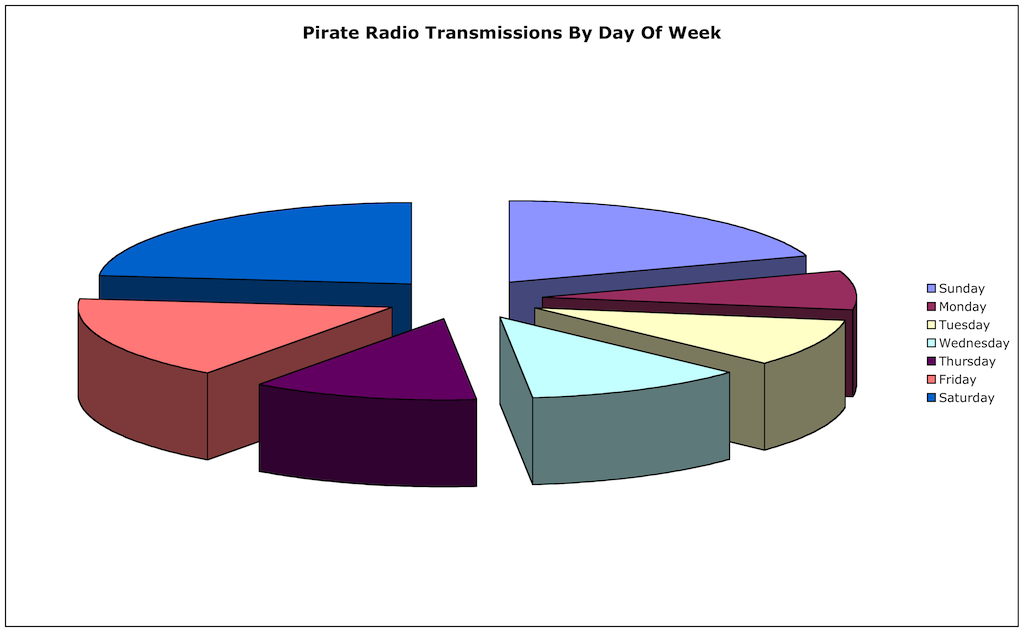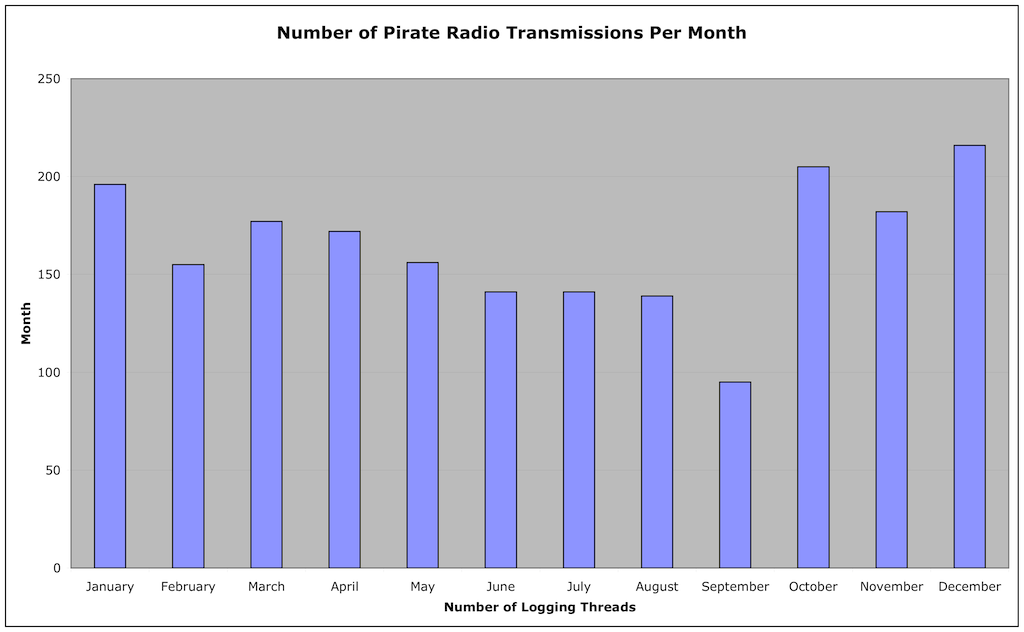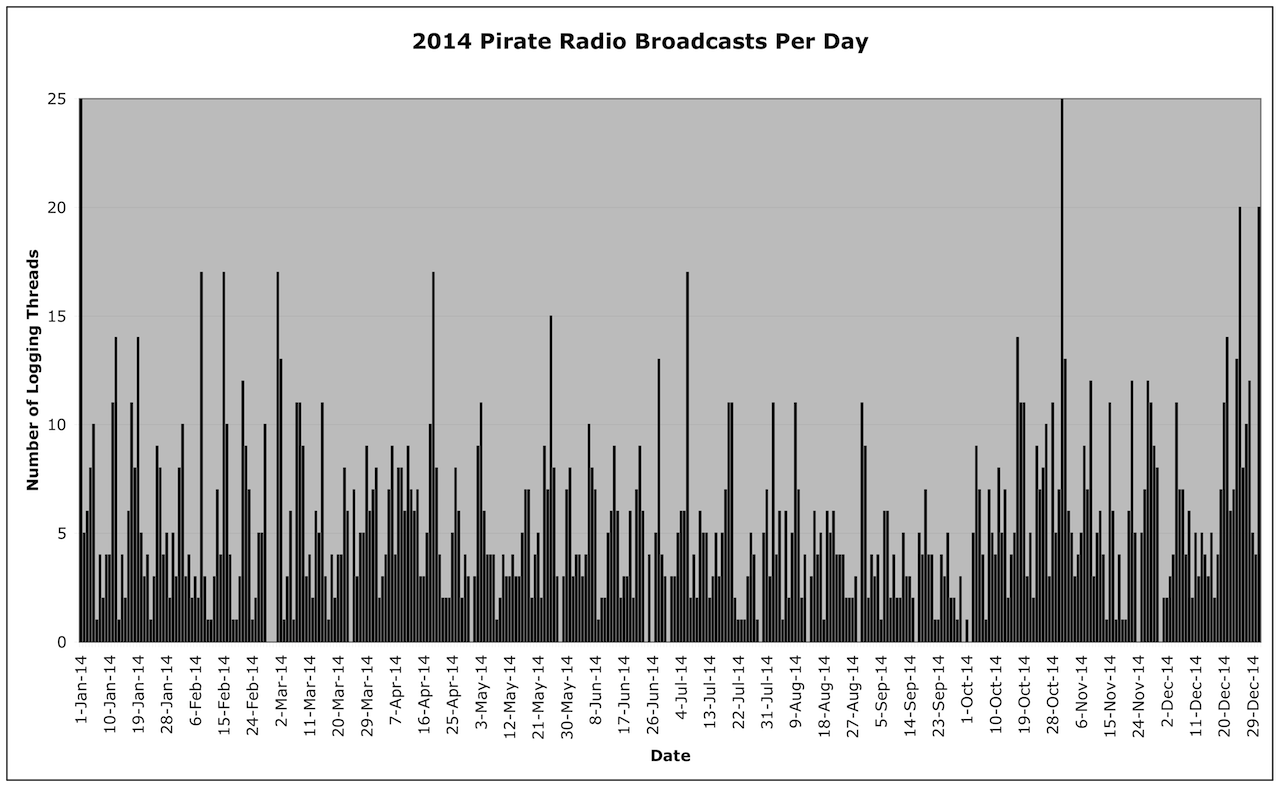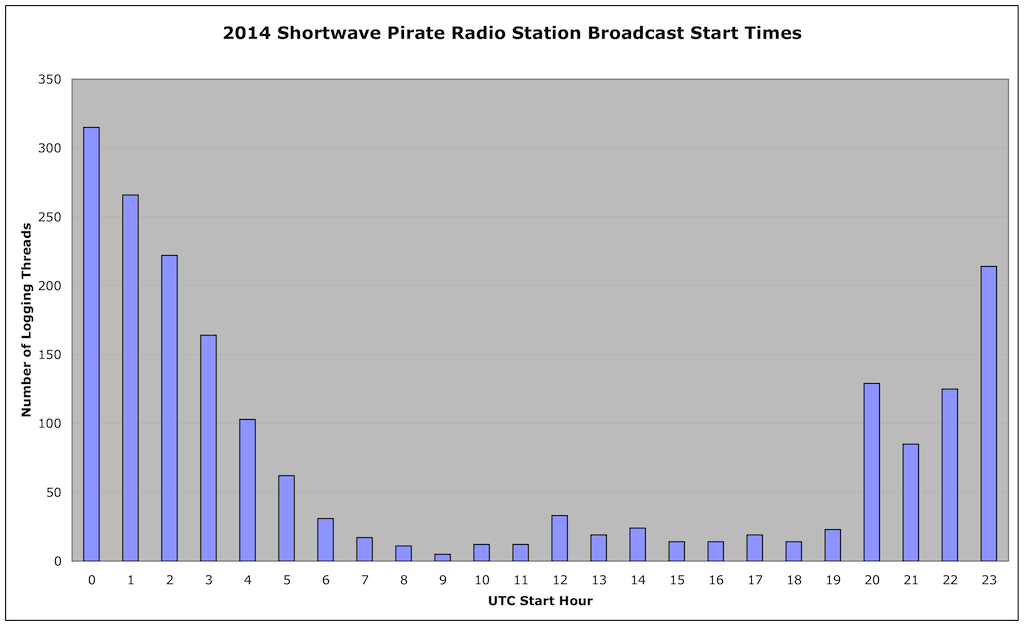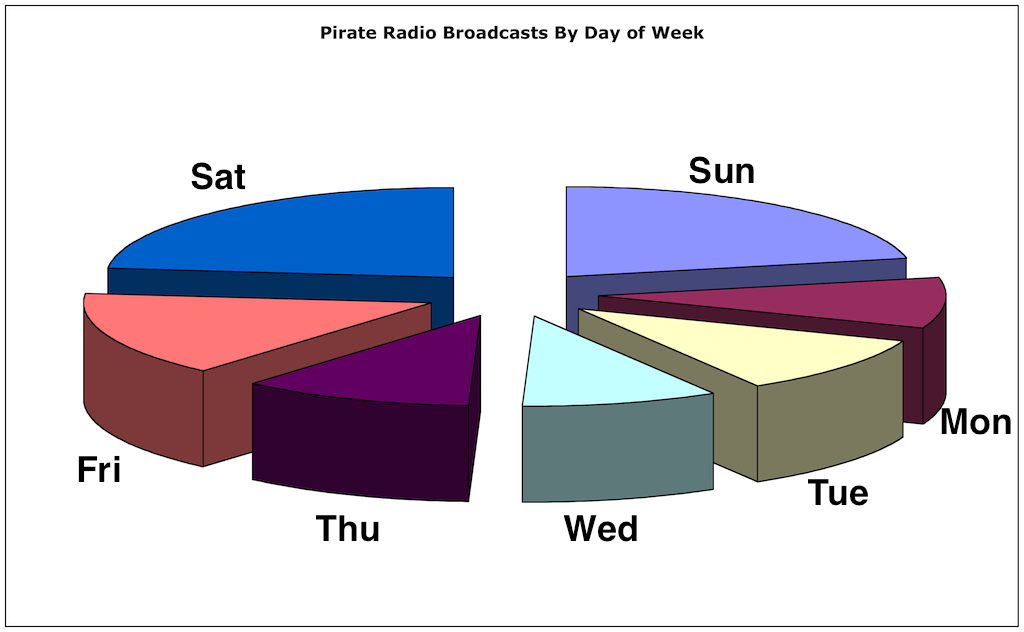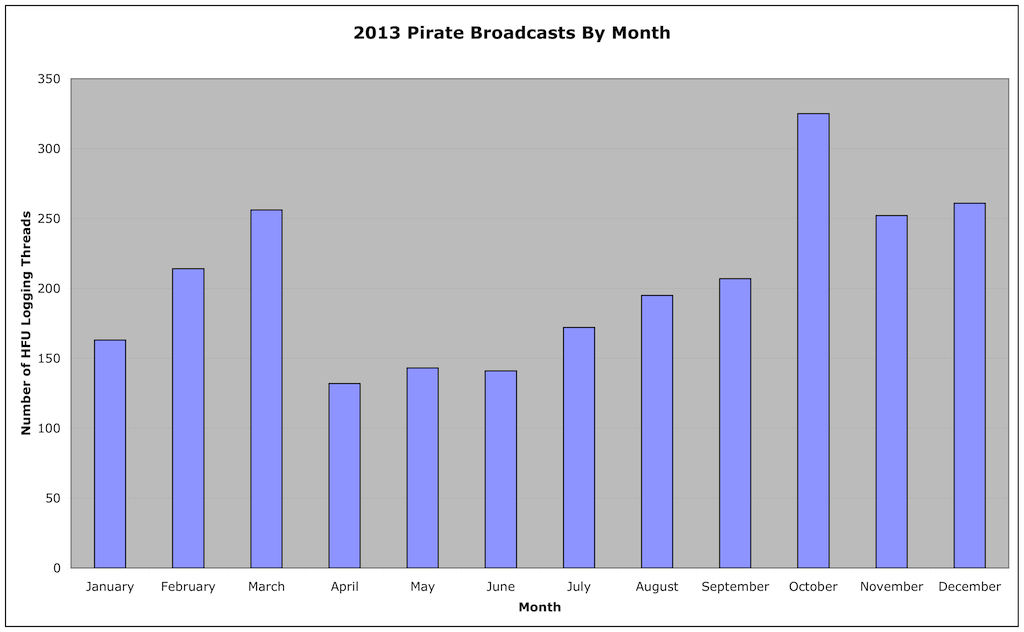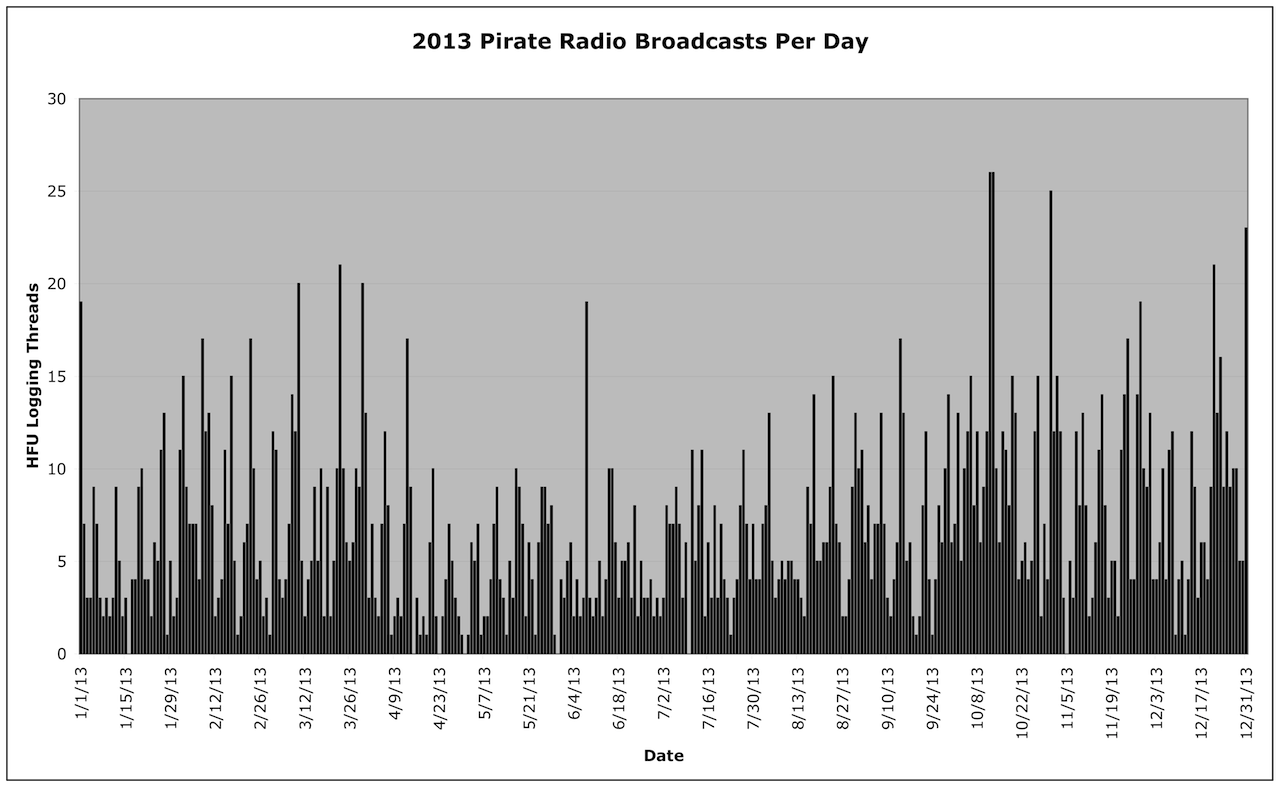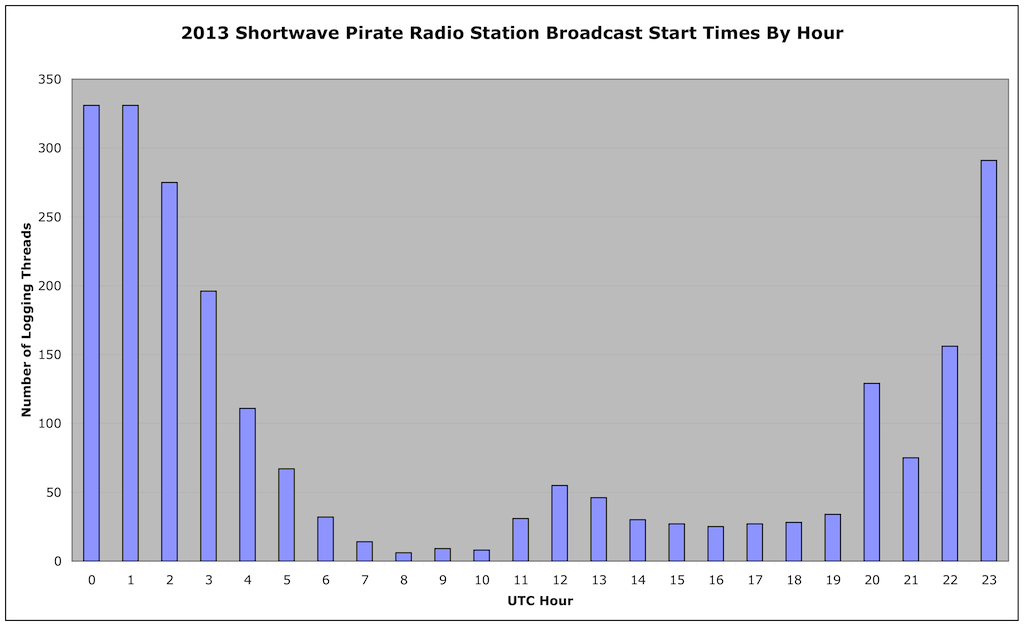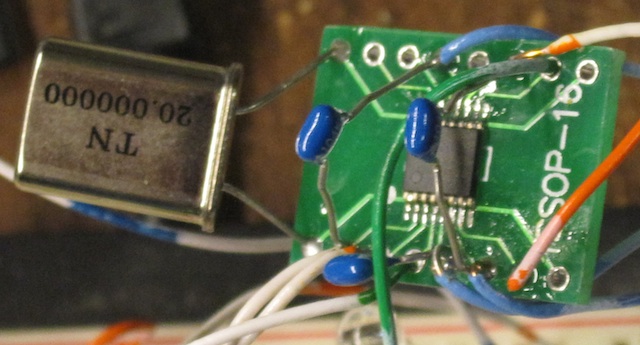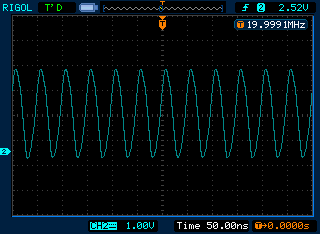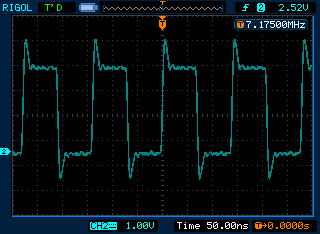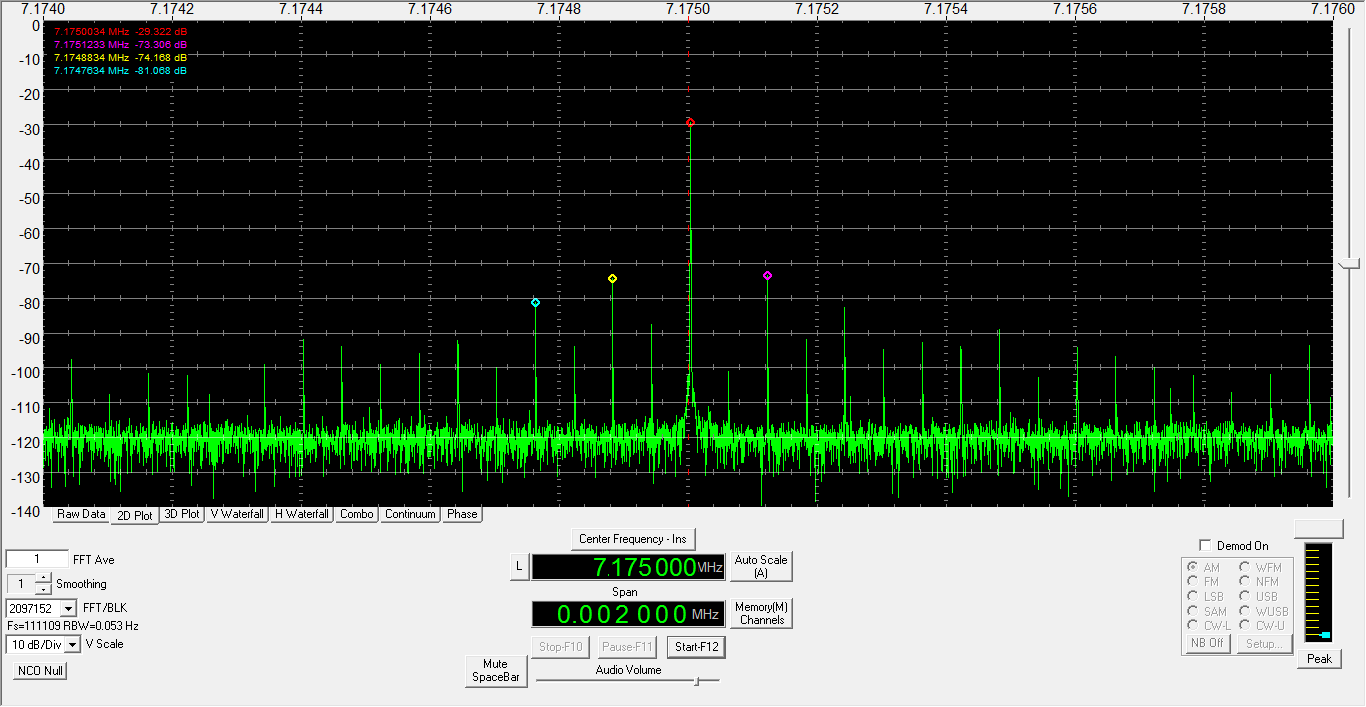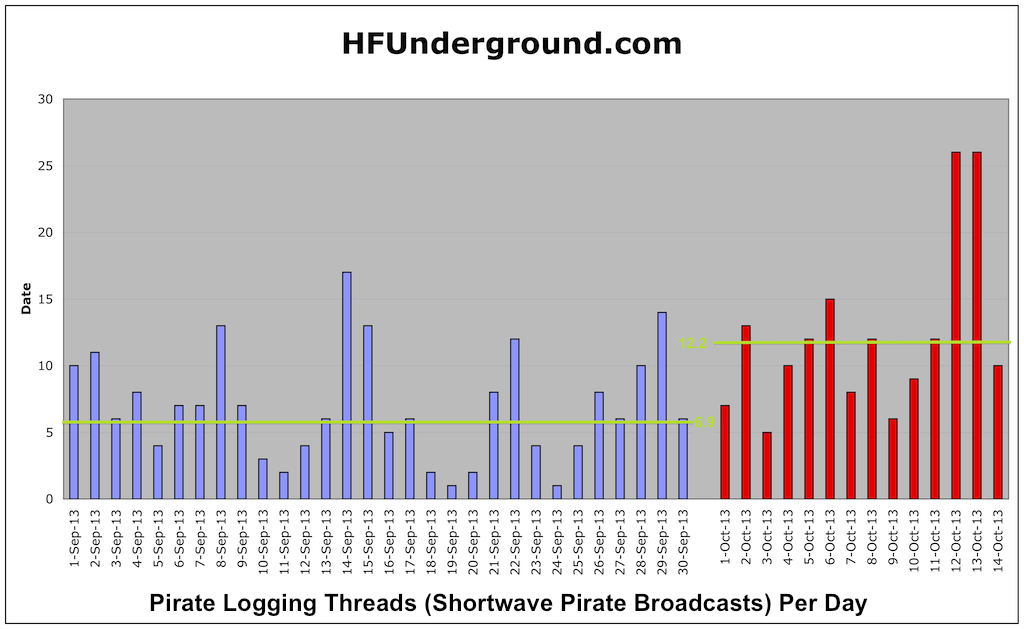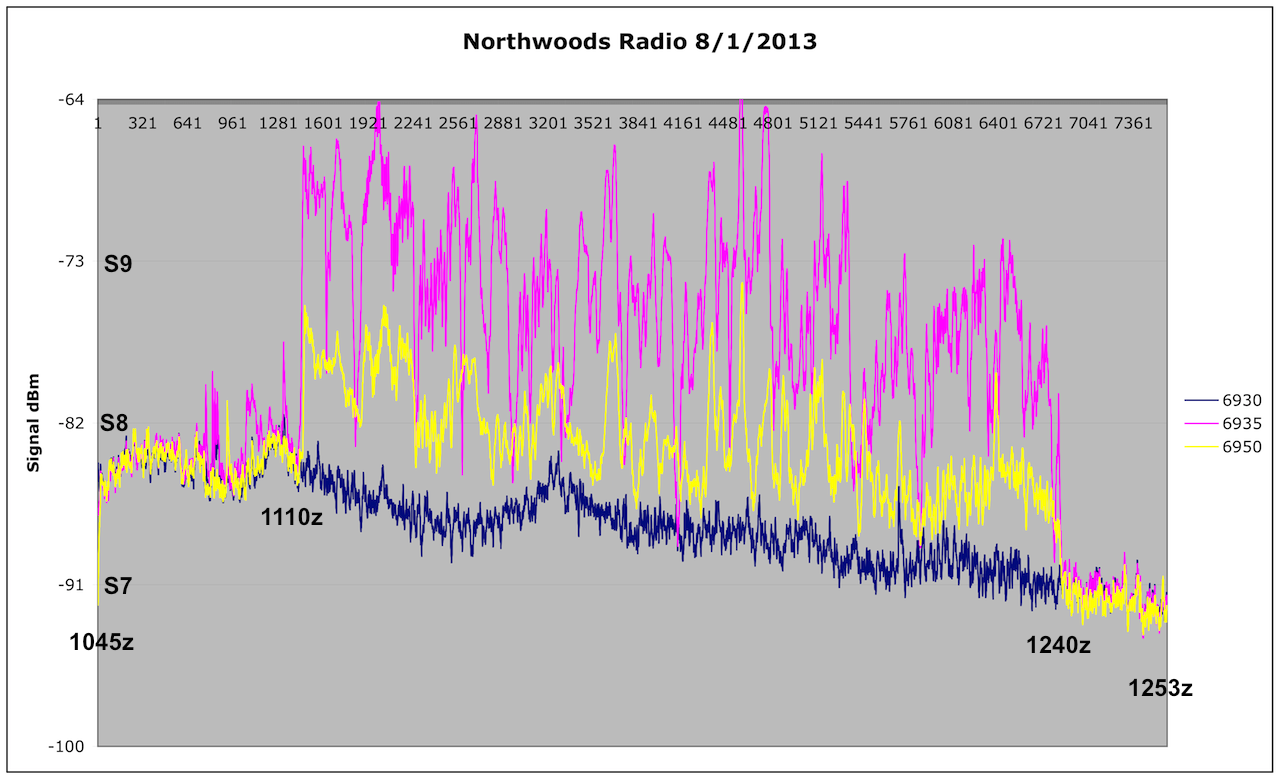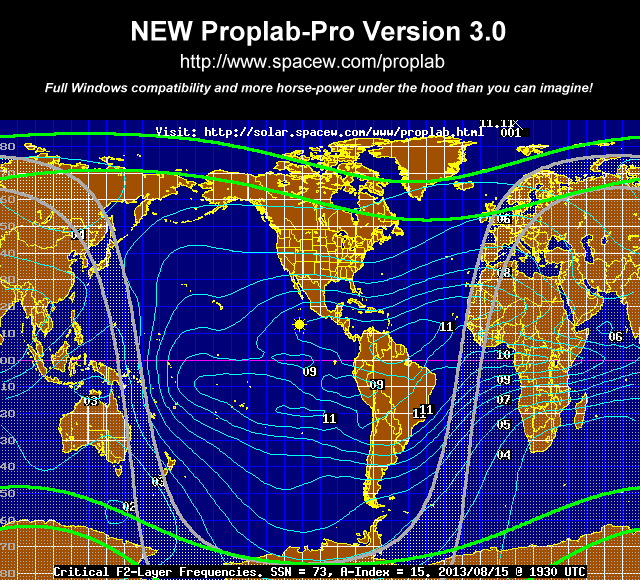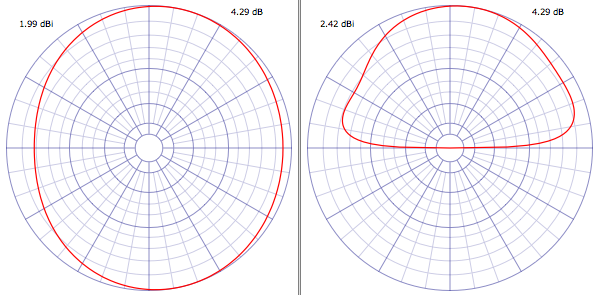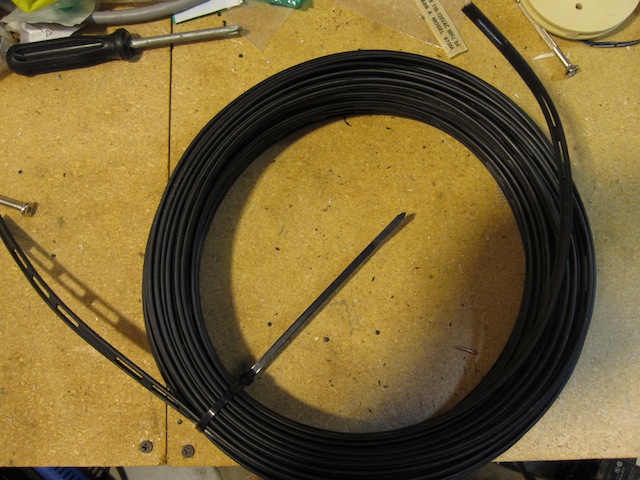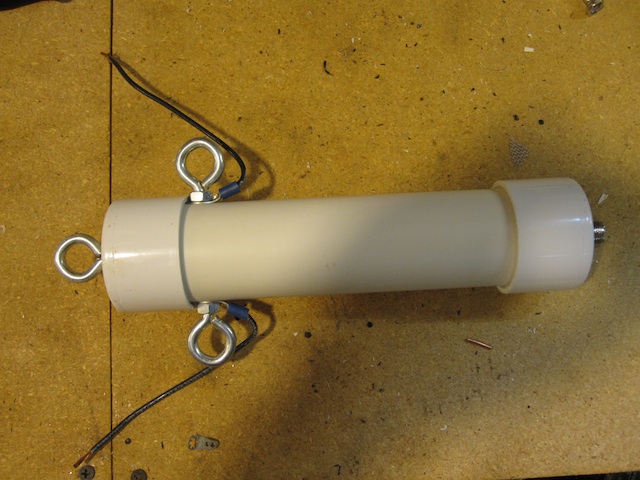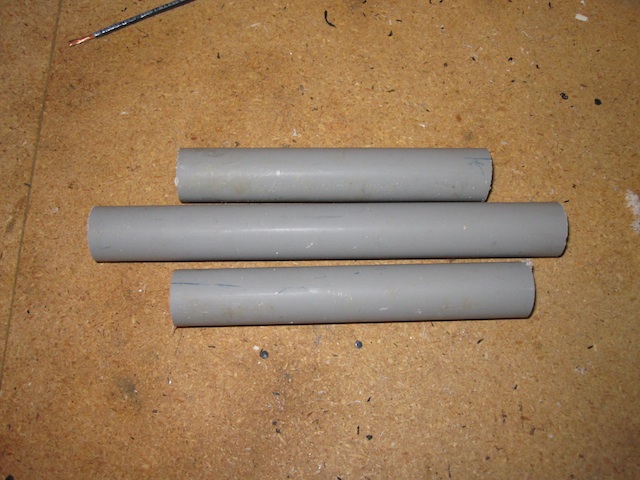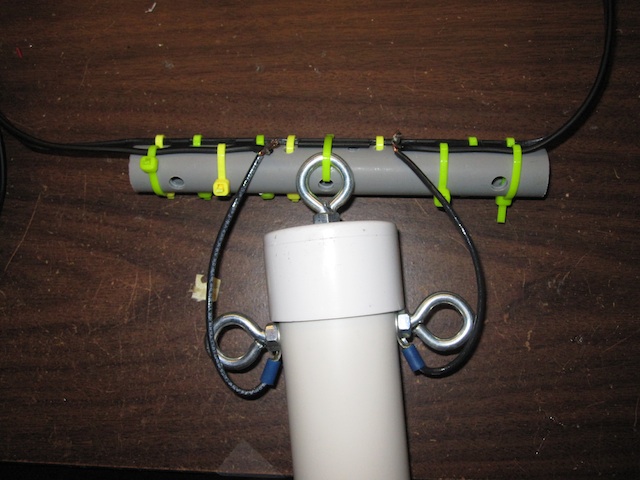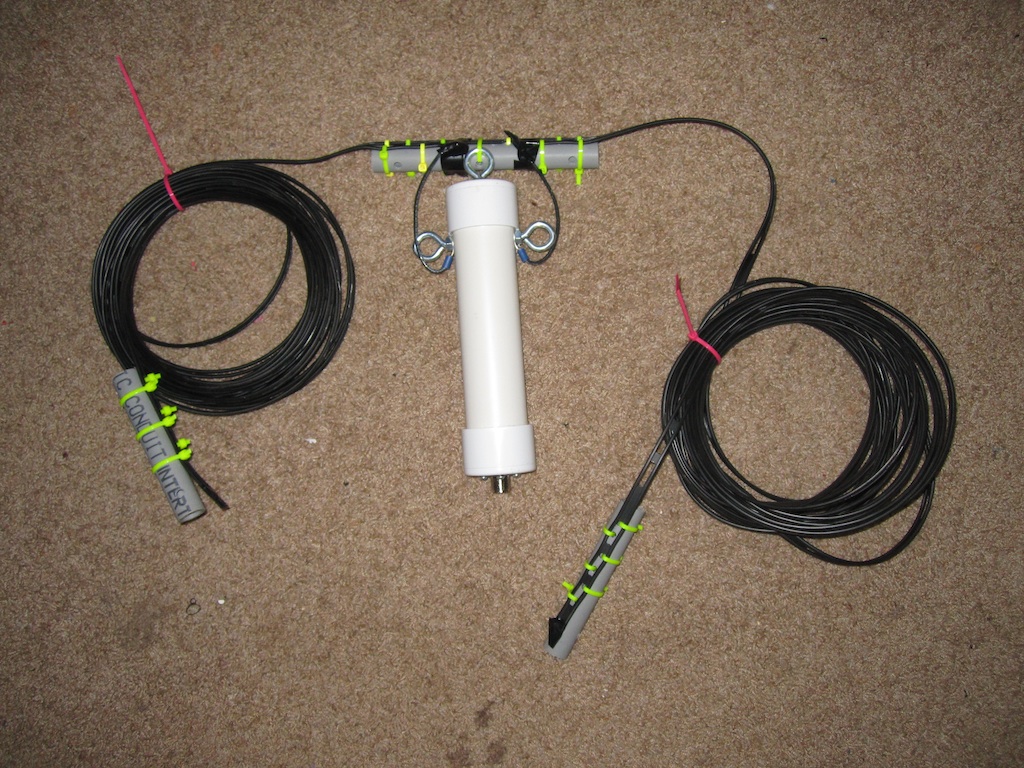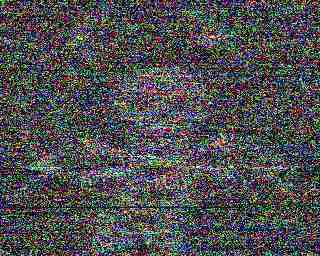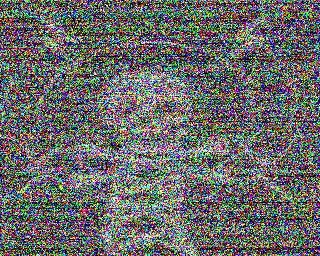To gauge shortwave pirate radio activity in 2015, I analyzed the loggings to the HF Underground (http://www.hfunderground.com) message board. A computer script parsed the message thread titles, as well as the timestamps of the messages. This information was used to produce some statistics about the level of pirate radio activity. Of course, as Mark Twain has written: “There are three kinds of lies: lies, damned lies, and statistics.” Still, let’s see what we can learn.
There were 13,944 messages posted to 2,183 unique threads, that’s a 10% increase in the number of messages over 2014. Ideally, each thread represents an individual pirate station transmission. Also ideally, each message posted to a thread represents one logging. In reality, there is some error involved.
First, we can look at the transmission mode used:
AM 996
USB 954
LSB 39
CW 17
FM 11
SSTV 57
UNKNOWN 109
sum: 2183
AM barely beat out USB this year, last year there were 944 AM transmissions vs 776 USB. If we assume (as likely) that the cases where no mode was reported were one of these, AM and USB account for virtually all of the transmissions. Cold Country Canada is the major user of LSB, along with Peskie Party Radio.
SSTV was broken out just to show about how many SSTV transmissions there are, these of course are almost all transmitted in USB mode. Also, these are cases where SSTV is in the logging title, which means that the transmission was probably just SSTV, vs a station that also happened to transmit SSTV as part of the program, such as Wolverine Radio commonly does.
Next, we can see how much activity there is for each day of the week:
Sunday 449 (21%)
Monday 167 (8%)
Tuesday 172 (8%)
Wednesday 187 (9%)
Thursday 249 (11%)
Friday 366 (17%)
Saturday 593 (27%)
As one might expect, Saturday and Sunday are the big winners, with Friday in third place. But don’t give up on weekday listening! Over a third of all transmissions are on a Monday through Thursday.
We can also look at the number of logging threads per month, to gauge activity:
After a relatively flat trend during the first half of the year, activity really took off during the second half.
Here’s a graph showing the number of broadcasts per day of the year that were logged, please click on the image to see it full sized:
Holidays are, as usual, a great opportunity to hear pirate stations.
We might be interested in knowing the best time of the day to try for a station. Here’s a plot of the start times of the logged broadcasts, binned
by UTC hour of the day:
As you might expect, evening Eastern Time is the best, roughly 2300-0200 UTC, with a broader peak of lower activity from roughly 2000-0500 UTC. There is some activity in the morning to afternoon time period, and very little during the wee hours.
The next question is where to tune. As one might expect, 6925 kHz was the clear winner:
3440 kHz: 8
6150 kHz: 14
6770 kHz: 110
6850 kHz: 30
6873 kHz: 23
6874 kHz: 9
6875 kHz: 15
6876 kHz: 33
6880 kHz: 8
6900 kHz: 6
6919 kHz: 7
6920 kHz: 9
6922 kHz: 4
6923 kHz: 8
6924 kHz: 78
6925 kHz: 782
6926 kHz: 16
6927 kHz: 6
6928 kHz: 5
6929 kHz: 13
6930 kHz: 109
6932 kHz: 12
6933 kHz: 5
6934 kHz: 9
6935 kHz: 76
6939 kHz: 10
6940 kHz: 38
6945 kHz: 23
6948 kHz: 4
6949 kHz: 21
6950 kHz: 274
6951 kHz: 14
6952 kHz: 10
6954 kHz: 9
6955 kHz: 121
6956 kHz: 7
6960 kHz: 23
6962 kHz: 12
6964 kHz: 6
6965 kHz: 18
6969 kHz: 75
6970 kHz: 4
6974 kHz: 4
6975 kHz: 9
7540 kHz: 4
7590 kHz: 7
6925, along with 6924 and 6926 kHz, account for about 40% of logged transmissions. Last year they accounted for 50%, so there has been some movement to other frequencies. Also worth considering is that Old Time Radio’s use of 6770 kHz accounts for about 9% of the broadcast threads.
Just a few weeks ago, 3440 kHz started to get some use, due to 43 meters “going long” and being unusable for short distance reception at night. Whether or not this trend will continue remains to be seen. It’s a great frequency for nighttime use, but not as many listeners check it out, or have decent antennas for 90 meters.
The most popular station logged is of course “UNID”, short for unidentified. In the world of shortwave pirate radio, there’s a number of transmissions where no ID is given. There’s also cases where no ID could be heard, due to poor conditions. This year, 801 out of 2,183 threads were UNID, or about 37 percent. For 2014, there were 651 threads with 2,788 loggings where no station ID was given – that’s almost 33 percent of the threads.
Here’s the complete list of all stations with two or more logging threads:
UNID (801)
Liquid Radio (134)
Old Time Radio (112)
Amphetamine Radio (108)
XLR8 (75)
Cold Country Canada (74)
The Crystal Ship (57)
Radio Free Whatever (47)
Ghost Shortwave (41)
Captain Morgan (38)
Radio Ga Ga (32)
Moonlight Radio (31)
PeeWee Radio (31)
Wolverine Radio (30)
Radio True North (26)
CKUT Relay (20)
Burn It Down Radio (19)
Channel Z (18)
Insane Radio (17)
Rave On Radio (16)
Boombox Radio (15)
Toynbee Radio (14)
BBC Pirate Radio (14)
XFM (13)
WREC (12)
WMID (11)
Northwoods Radio (10)
KVR (10)
Blue Ocean Radio (9)
Pirate Radio Boston (9)
WPIG (8)
Radio Ronin (7)
Undercover Radio (7)
Radio Casablanca (7)
Random Radio (7)
Happy Hanukkah Radio (7)
Radio Dr Tim (7)
KCPR (7)
Canadian Radio After Dark (7)
Radio Fusion Radio (7)
THX1138 (7)
X Minus One (7)
Appalachia Radio (6)
WRR (6)
Free Thinker Radio (6)
Solar Centric Radio (6)
CPRRS (6)
KOTH (6)
WHYP (5)
Radio Gallifrey Intergalactic (5)
Partial India Radio (5)
Vivian Girls Radio (5)
WJD (5)
Radio Illuminati (5)
Brockett 99 (5)
Radio Broadcaster (5)
KHAT (5)
KIPM (4)
WAZU (4)
Renegade Radio (4)
WLIS (4)
Peskie Party Radio (4)
WEZY (4)
Javelina Radio (4)
Pirate Clip Radio (4)
CYOT (3)
WBOG (3)
Cool AM (3)
Mushroom Radio (3)
Radio Clandestine (3)
Radio Paisano (3)
WOLF (3)
Twangy Radio (3)
WAHR (3)
Drunken DJ Radio (3)
The Bangalore Poacher (3)
Weather Control Radio (3)
Radio Caroline (3)
Network 51 (3)
Big Johnson Radio (3)
WPOD (2)
Chamber Pot Radio (2)
Turtlehead Radio (2)
Radio Free Mars Radio (2)
Hard Tack Radio (2)
Germany Calling (2)
Radio Azteca (2)
XEROX (2)
Frederick Chopin Radio (2)
Black Cat Radio (2)
KAMP (2)
Fruitcake Station (2)
Satan Radio (2)
Radio Halloween (2)
YHWH (2)
KBOX (2)
Generation Wild 100 (2)
Radio Free ADD (2)
Girl Scout Radio (2)
New Horizons Radio (2)
Nordic Wind Radio (2)
Stars And Stripes (2)
Up Against The Wall Radio (2)
Kid From Brooklyn (2)
Another thing we can look at are the total number of posts in all logging threads for each station, as a rough guide to how many listeners heard a particular station. There’s duplication of course, as the same listener likely reported several broadcasts for each station:
Liquid Radio (872)
Amphetamine Radio (735)
XLR8 (683)
The Crystal Ship (584)
Radio Free Whatever (575)
Wolverine Radio (505)
Cold Country Canada (413)
Old Time Radio (380)
Ghost Shortwave (349)
Captain Morgan (247)
Burn It Down Radio (203)
XFM (196)
Moonlight Radio (194)
PeeWee Radio (194)
Radio True North (184)
Radio Ga Ga (184)
Insane Radio (141)
CKUT Relay (139)
Channel Z (136)
Radio Casablanca (115)
Rave On Radio (111)
WMID (101)
WREC (99)
Northwoods Radio (95)
Boombox Radio (95)
Drunken DJ Radio (90)
BBC Pirate Radio (85)
Random Radio (76)
Free Thinker Radio (75)
THX1138 (62)
X Minus One (62)
Undercover Radio (58)
Appalachia Radio (57)
WPIG (56)
KCPR (55)
Radio Gallifrey Intergalactic (54)
Blue Ocean Radio (53)
WRR (53)
Toynbee Radio (49)
Pirate Radio Boston (48)
Canadian Radio After Dark (48)
Radio Fusion Radio (48)
Pirate Clip Radio (43)
Happy Hanukkah Radio (41)
Mushroom Radio (39)
Girl Scout Radio (38)
KHAT (38)
Brockett 99 (37)
WPOD (36)
Radio Broadcaster (36)
Peskie Party Radio (35)
Germany Calling (34)
Generation Wild 100 (34)
CPRRS (34)
Radio Ronin (32)
Twangy Radio (32)
WHYP (31)
Hard Tack Radio (31)
Radio Halloween (31)
WAHR (30)
Solar Centric Radio (30)
Renegade Radio (29)
KVR (29)
Up Against The Wall Radio (29)
KIPM (28)
Radio Clandestine (28)
WJD (28)
KOTH (28)
Partial India Radio (27)
New Horizons Radio (27)
Javelina Radio (27)
Radio Illuminati (26)
Radio Dr Tim (25)
Nordic Wind Radio (25)
CYOT (23)
WLIS (22)
WEZY (21)
Big Johnson Radio (21)
WBOG (20)
WOLF (20)
Cool AM (19)
WAZU (18)
The Bangalore Poacher (17)
Weather Control Radio (17)
XEROX (16)
Frederick Chopin Radio (16)
Network 51 (16)
Radio Azteca (15)
Radio Caroline (14)
Radio Paisano (13)
Vivian Girls Radio (13)
Radio Free Mars Radio (12)
KBOX (12)
Kid From Brooklyn (12)
Stars And Stripes (9)
Turtlehead Radio (8)
Satan Radio (8)
YHWH (8)
Black Cat Radio (7)
Radio Free ADD (7)
Chamber Pot Radio (5)
KAMP (4)
Fruitcake Station (4)
Next we can calculate the ratio of logging messages per thread, to gauge, in general, how many people reported hearing each station:
Liquid Radio 872 134 6.50746
Amphetamine Radio 735 108 6.80556
XLR8 683 75 9.10667
The Crystal Ship 584 57 10.2456
Radio Free Whatever 575 47 12.234
Wolverine Radio 505 30 16.8333
Cold Country Canada 413 74 5.58108
Old Time Radio 380 112 3.39286
Ghost Shortwave 349 41 8.5122
Captain Morgan 247 38 6.5
Burn It Down Radio 203 19 10.6842
XFM 196 13 15.0769
Moonlight Radio 194 31 6.25806
PeeWee Radio 194 31 6.25806
Radio True North 184 26 7.07692
Radio Ga Ga 184 32 5.75
Insane Radio 141 17 8.29412
CKUT Relay 139 20 6.95
Channel Z 136 18 7.55556
Rave On Radio 111 16 6.9375
WMID 101 11 9.18182
WREC 99 12 8.25
Boombox Radio 95 15 6.33333
BBC Pirate Radio 85 14 6.07143
Toynbee Radio 49 14 3.5
For each station, the first number is the total number of reports, the second is the number of threads, the third is the ratio. One risk here is that the same transmission could be logged in two, or even more, threads, which would reduce this ratio.
We can then sort these by ratio:
16.8333,Wolverine Radio
15.0769,XFM
12.234,Radio Free Whatever
10.6842,Burn It Down Radio
10.2456,The Crystal Ship
9.18182,WMID
9.10667,XLR8
8.5122,Ghost Shortwave
8.29412,Insane Radio
8.25,WREC
7.55556,Channel Z
7.07692,Radio True North
6.95,CKUT Relay
6.9375,Rave On Radio
6.80556,Amphetamine Radio
6.50746,Liquid Radio
6.5,Captain Morgan
6.33333,Boombox Radio
6.25806,Moonlight Radio
6.25806,PeeWee Radio
6.07143,BBC Pirate Radio
5.75,Radio Ga Ga
5.58108,Cold Country Canada
3.5,Toynbee Radio
3.39286,Old Time Radio
Avg Ratio 7.99587
Note: The above table only includes stations with 11 or more logging threads. I have posted an addendum that includes all stations, even down to those with just one thread.
This year’s results are somewhat less straightforward, due to a station nicknamed “Old Time Radio”. It has transmitted almost 24/7 (with some breaks for a few days) since around April, usually on 6770 kHz. Sometimes the same logging thread was used for several days worth of loggings. How many transmissions has it made? Sometimes it has been on for weeks at a time. Certainly in terms of the number of hours transmitted, it is the most active pirate radio station by far for 2015, as it was in 2014. No other station comes close.





